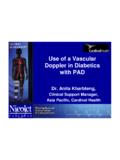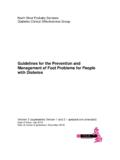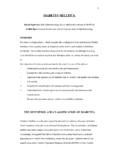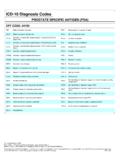Transcription of Screening for Diabetic Peripheral Neuropathy
1 NEUROPATHYOCTOBER 2004I Diabetic MICROVASCULAR COMPLICATIONS TODAY I17 Diabetic Peripheral Neuropathy (DPN) is verycommon among patients with type 2 dia-betes and a pivotal component of foot dis-ease, therefore it is vital that physicians payclose attention to Screening . The objectives of screeninginclude identifying the risk of ulceration in order toavoid amputation, identifying early nerve injury, andevaluating areas for clinical International Neuropathy Guidelines define DPNas the presence of symptoms and/or signs of peripheralnerve dysfunction in people with diabetes after exclu-sion of other causes. Neuropathy can present with a lossof protective sensation, defined as a level of sensory losssufficient for a patient to injure himself or herself with-out recognizing the INSTRUMENTSMost Screening instruments for DPN are noninvasive,inexpensive, sensitive-specific and highly predictive ofclinical endpoints.
2 To evaluate a patient for Neuropathy ,clinicians needs to ask patients about signs and symp-toms, perform a thorough physical exam, including deeptendon reflexes, motor strength and vibration; as well asperform diagnostic studies such as nerve conductionvelocities (NCV).A single instrument may not be sufficient for should use a history-symptom ques-tionnaire, a physical exam, Semmes-Weinstein monofila-ments (SWM) , vibration perception threshold (VPT)evaluation and a true sensitivity and specificity for VPT,SWM and nerve conduction is difficult because there isno true gold standard among these instruments. Severalstudies have reported a strong correlation between VPT,NCV results and subjective symptoms of questionnaires are helpful in Screening patientsfor DPN. These are the Michigan Neuropathy ScreeningInstrument (Table 1),6 Neuropathy Symptom Profile, Neuropathy Symptom Score, Diabetic NeuropathySymptom Score (Table 2),7and the UT AbbreviatedNeuropathy ,8 The Diabetic Neuropathy Symptom Score has beenevaluated in 73 Diabetic studies, comparing it with clini-cal testing with SWM and VPT.
3 It was found to have areliability of , a sensitivity of 79% and a specificity of78%.7A physical exam of the patient should include closeinspection, with shoes and socks removed. The physicianshould perform deep tendon reflexes, vibration with a128-Hz tuning fork; sharp, dull and light touch; andmotor North West Diabetes Foot Care Study predictedneuropathic foot ulcer risk in 9,710 Diabetic patients fol-lowed for 2 was a population-based study inthe North West United Kingdom, carried out in sixhealth care districts. To determine a neuropathic disabil-ity score (NDS), three sensory modalities were used:vibration with a 128-Hz tuning fork, pinprick with aScreening for DiabeticPeripheral NeuropathyScreening patients thoroughly can help identify nerve injury LAWRENCE A. LAVERY, DPM, MPH; DAVID G.
4 ARMSTRONG, DPM, MSC; AND ANDREW BOULTON, MD Are your feet numb Burning pain Feet sensitive to thetouch Able to sense feetwhen walking Can you tell hot fromcold water Have you had an ulcer Doctor-diagnosedneuropathy Do you feel weak Symptoms worse atnight Do legs hurt when youwalk Prickling feeling Muscle cramp Bed covers hurt yourskin Does skin crack open Have you had anamputationTABLE 1. MICHIGAN NEUROPATHYSCREENING INSTRUMENTN eurotip device, and hot-cold rods. A score of 0 wasnormal and 1 was abnormal. The ankle reflex was scored0 for normal, 1 for reinforcement and 2 for absent. Themaximum total of 5 for each foot led to a potentialmaximum score of 10 (lower being less severely affect-ed).In this study, 291 ulcers developed. The researchersfound that NDS was the best baseline predictor.
5 A scoreof <6 translated to a annual ulcer incidence and ascore of >6 translated to a annual ulcer TESTINGThe SWM for sensory testing was popularized for theinsensate foot from research and education coursestaught at the Hansen Disease Center in Carville, La.(Figure 1).3 The monofilaments produce a characteristicforce perpendicular to the contacting surface. The forceof downward contact increases linearly until themonofilament buckles. The three digit numbers of theSWM are the common log of the characteristic force ingrams plus the constant force. The set of forces rangefrom mg to 447 g and is nearly log-linear (Table 3).While the SWM is accurate and durable, there are vari-ous recommendations for interpreting the data andinconsistent testing methods associated with it. Thereare also different sites of testing on the foot (Figure 2).
6 Other variables affect the reproducibility and accuracyof SWM, such as the physical properties of the unit, is itcalibrated or uncalibrated, the unit s condition, as well asmaterial wear and have sought to determine whether SWM test-ing is accurate and Researchers have foundthat there is wide variability in the load characteristics atbaseline and with continued loading. The reproducibilityof testing decreased with repetitive loading, and recov-ery after 24 hours improved the test s have also evaluated the service life of a a review of the New Touch-Test SensoryMonofilament (North Coast Medical),10 researchersfound that the initial average force generated was g ( to g). After 500 loading cycles, there wasabout a decrease to g ( to g). Theyfound that a 24-hour recovery period improved accura-cy to g ( to g).
7 Another study compared four commercially available10-g SWM units. The investigators identified a large vari-ation in loading forces and found that 20% to 100%demonstrated buckling g ( to g).Furthermore, repeated use of the devices throughoutthe day led to a far lower buckling force, thus leadingthe clinician to overdiagnose the loss of protective can fail for several reasons: they canbecome damaged, old and uncalibrated. This con-tributes to lower loading forces and an overdiagnosis ofperipheral sensory Neuropathy . Monofilament unitsshould be replaced frequently and only calibrated instru-ments should be used. Throwaway or give-away devicesare of questionable quality and PERCEPTION THRESHOLD VPT testing is the most widely used quantitative sen-sory testing approach. VPT is associated with large nor-mative and Neuropathy databases.
8 VPT evaluation fulfillsthe key criteria that make it desirable for longitudinalcohort evaluation: The instrument is sensitive, specificand diabetics, the coefficient of variation for vibra-tion testing is in the range of 10% to 20%. VPT testing isadministered at the distal pulp of the hallux, over thebony prominence. The voltage is increased on the baseunit until the patient can perceive a prospective study of Neuropathy and foot ulcera-tion looked at 1,035 patients in multiple Diabetic MICROVASCULAR COMPLICATIONS TODAY IOCTOBER 2004 Figure 1. SWM for sensory testing may vary widely. Four-item symptom score 1 point for each positive response- unsteadiness in gait- pain, burning or aching of the feet or legs- prickling sensation of the feet or legs- numbness in the feet or legsTABLE 2.
9 Diabetic Neuropathy SYMPTOM SCORENEUROPATHYOCTOBER 2004I Diabetic MICROVASCULAR COMPLICATIONS TODAY I19 Patients had no history of ulcers, VPT >25 volts and pal-pable pulses. Patients had standardized educationregarding foot care and three monthly visits. The annualincidence of foot ulcers was , with an increase per volt advantage of VPT testing is that the instrument iscalibrated so it should not vary with use. There is nopotential for material failure and it does not need to for DPN testing is noninvasive and readily avail-able. The technique is most sensitive for detecting earlychanges and has a low coefficient of variation (peronealnerve <10%).12,13 NCV can be used prior to the develop-ment of clinical signs and symptoms and it is helpful forpredicting new is not necessarily a Screening instrument and itmay be costly.
10 It also may not provide actionable data orchange the course of summary, because Neuropathy is a common com-plication among patients with diabetes, evaluation andmanagement of these patients is vital. Neuropathy is amajor component of foot disease. Lawrence A. Lavery, DPM, MPH, is associate professor ofsurgery at Texas A&M Health Science Center College ofMedicine. He is consultant for Eli Lilly and Company(Minneapolis), KCI Inc. (San Antonio), Xilas Medical (SanAntonio), XLHealth (Baltimore) and Prizm Medical(Duluth, Ga.). He owns stock and is on the clinical advisoryboards of Xilas and XLHealth. 1. Armstrong DG. The 10-g monofilament: the diagnostic divining rod for the Diabetic foot? ;23 Young MJ, Breddy JL, Veves A, Boulton AJ. The prediction of Diabetic neuropathic foot ulcerationusing vibration perception thresholds.








